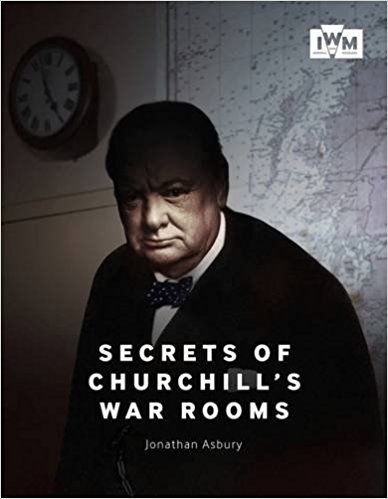
Finest Hour 176
Books, Arts & Curiosities – The Seat of Power

July 5, 2017
Finest Hour 176, Spring 2017
Page 47
Review by Warren Dockter
Jonathan Asbury, Secrets of Churchill’s War Rooms, Imperial War Museum, 2016, 224 pages, £30/$45. ISBN: 978–1904897491
Visiting the Churchill War Rooms is a powerful experience. The secrecy, urgency, and importance housed within the walls immediately surround and intoxicate your senses. Solemnly pacing the halls, peering into the map room, and perusing the exhibits gives you a feeling of their immense historical importance. You can almost smell wafts of Churchill’s cigar smoke as you contemplate how he and others like General Brooke and General Ismay directed the war. Replicating that experience with a book might prove a difficult task. Jonathan Asbury’s Secrets of Churchill’s War Rooms, however, does so with aplomb. Published by the Imperial War Museum, the book provides an informative and engaging account of life in Churchill’s bunker.
Asbury’s book joins the ranks of several other texts written on the subject including The Cabinet War Rooms (1996), The Churchill Museum and Cabinet War Rooms (2005), and more recently Richard Holmes’s final book, Churchill’s Bunker: The Secret Headquarters at the Heart of the War (2011). Like those books, Asbury relies a great deal on the account of the first “inhouse” historian at the War Rooms, Peter Simkins. Asbury admirably pays respect to Simkins’s work, The Cabinet War Rooms (1968) in his acknowledgements and notes that Simkins himself “played a major role in the preservation and restoration of the site” (219). But as a testament to Asbury’s thoroughness and thoughtfulness, he reminds his readers of the role Nigel de Lee, a historian from the Royal Military Academy, played in preparing an unpublished history of the War Rooms. De Lee’s work informed both the accounts of Simkins and that of Jon Wenzel, the first Curator of the War Rooms, in his curation of the site right down to the correct furniture required.
While Asbury employs a familiar structure, expediently covering the context of the war at the beginning of each chapter, this particular history of the War Rooms stands above its peers for two primary reasons. The first is the final section, which chronicles the preservation and curatorship of the space. This dimension of the museum’s history has remained fairly absent from most accounts and is a welcome addition, which showcases the time, effort, and care that went into fashioning the War Rooms as we know them today. People like Simkins, de Lee, and Wenzel played a major part in shaping how we think about the role of Churchill during the war, and this has been somewhat overlooked in the past.

2024 International Churchill Conference
The second and even more impressive reason this book is a welcome addition to the Churchill canon is the exceptionally good photography of Andrew Tunnard found throughout the book. His images illustrate the historical weight of their subjects. The low ceilings, cramped conditions, and poor lighting of the Dock convey the claustrophobic working conditions for Churchill’s staff during the war. The comic caricature of Adolf Hitler and “clouds” of pinholes on the enormous global map reveal the staff’s dynamic nature and sense of humour. But perhaps the most impressive photo of all is a simple close shot of Churchill’s chair in the Cabinet Room. Though I have personally visited the War Rooms numerous times, I never before noticed what this photo captures: the scratch marks made by Churchill on the arms of his chair revealing the energy, tension, and pressure he must have experienced during the many hours he sat there managing the war effort. Visitors to the museum must stand too far away from the prime minister’s seat to be able to see this themselves. Here was a secret revealed indeed.
Warren Dockter is Lecturer in International Politics at Aberystwyth University and author of Churchill and the Islamic World (2015).
Subscribe
WANT MORE?
Get the Churchill Bulletin delivered to your inbox once a month.


